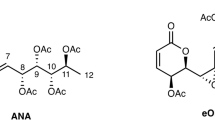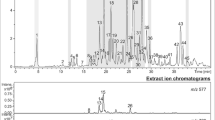Abstract
The antinociceptive properties of the hydro-methanolic extract (HME) and two flavonoids isolated fromDanae racemosa have been investigated in several nociceptive rat models. The HME fromD. racemosa (100-400 mgkg-1, i.p.) produced significant dose-related inhibition of acetic acid-induced abdominal constriction. In the same dose range, the HME produced dose-related inhibition in both phases of a formalin-test. Treatment of animals with naloxone (5 mgkg-1, i.p.) completely reversed the antinociceptive effect caused by morphine (5 mgkg-1, s.c.) and the HME (200 mgkg-1, i.p.) when assessed against the first phase of the formalin-test, but this effect was less significant for the HME in the second phase. Furthermore, when assessed via a hot-plate test, the HME (100-400 mgkg-1, i.p.) caused a significant increase in response latency. The HME, given daily for to 7 consecutive days, develop tolerance, but did not induce cross-tolerance to morphine. These data demonstrate that the HME elicites pronounced anti-nociception against several pain models. The actions of the HME involve, at least in part, an interaction with the opioid system, but does not seem to be related with non-specific peripheral or central depressant actions. Finally, the active principle(s) responsible for the antinociceptive action ofD. racemosa is likely to be partially related to the presence of quercetin and kaempferol.
Similar content being viewed by others
Refrences
Ahmadiani, A., Hosseiny, J., Semnanian, S., Javan, M., Saeedi, F., Kamalinejad, M., and Saremi, S., Antinociceptive and anti- inflammatory effects ofElaeagnus angustifolia fruit extract.J. Ethnopharmacol., 72, 287–292 (2000).
Bailey, L. H., The Standard Cyclopedia of Horticulture, MacMillan, New York, p. 961, (1961).
Chung, K. M., Lee, K. C., Choi, S. S., and Suh, H. W., Differential roles of spinal cholera toxin-and pertussis toxin- sensitive G proteins in nociceptive responses caused by formalin, capsaicin, and substance P in mice.Brain Res. Bull., 54, 537–542(2001).
Dubuisson, D. and Dennis, S. G., The formalin test: a quantitative study of the analgesic effects of morphine, meperidine and brainstem stimulation in rats and cats.Pain, 4,161–174(1977).
Ferreira, J., Floriani, A. E. O., Filho, V. C., Monache, F. D., Yunes, R. A., Santos, C., and Santos, A. R. S., Antinociceptive properties of the methanolic extract and two triterpenes isolated fromEpidendrum mosenii stems (Orchidaceae).Life Sci., 66,791–802(2000).
Filho, A. W., Breviglieri, E., Cechinel Filho, V., and Santos A.R.S., Antinociceptive effect of the hydroalcoholic extract ofBauhinia splendens stems in mice.J. Pharm. Pharmacol., 49,823–827(1997).
Gallantine, F. L. and Meert, T. F., Attenuation of the gerbil writhing response by mu-, kappa- and delta-opioids, and NK- 1, -2 and -3 receptor antagonists.Brain. Res. Bull., 79, 125–135(2004).
Ghahraman, A., The Chromophytes of Iran, 1 ed. Tehran University Publication centre, Tehran, pp. 396–405, (1994).
Gorski, F., Correa, C. R., Cechinel Filho, V., Yunes, R. A., and Calixto, J. B., Potent antinociceptive activity of the hydroalcoholic extract fromPhyllanthus corcovadensis.J. Pharm. Pharmacol., 45,1046–1049 (1993).
Hamm, R. J., Pike, B. R., O’Dell, D. M., Lyeth, B. G., and Jenkins, L. W., The rotarod test: An evaluation of its effectiveness in assessing motor deficits following traumatic brain injury.J. Neurotrauma, 11,187–196 (1994).
Heidari, M. R., Azad, E. M., and Mehrabani, M., Evaluation of the analgesic effect ofEchium amoenum Fisch & C.A. Mey. extract in mice: Possible mechanism involved.J. Ethnopharmacol., 103, 345–349 (2006).
Hunskaar, S. and Hole, K., The formalin test in mice: dissociation between inflammatory and non-inflammatory pain.Pain, 30,103–114(1987).
Hunskaar, S., Fasmer, O. B., and Hole, K., Formalin test in mice, a useful technique for evaluating mild analgesics.J. Neurosci. Methods, 14,69–76 (1985).
Koster, R., Anderson, M., and Beer, E. J., Acetic acid for analgesic screening.Fed. Proc., 18,412 (1959).
Maleki, N., Garjani, A., Nazemiyeh, H., Nilfouroushan, N., Eftekhar Sadat, A. T., Allameh, Z., and Hasannia, N., Potent anti-Inflammatory of hydroalcoholic extract from aerial parts ofStachys Inflata on rats.J. Ethnopharmacol., 75, 213–218 (2001).
Maleki, N., Fathiazad, F., Garjani, A., and Safaii, M., Study on the anti-inflammatory and antinociceptive effects ofDanae racemosa.Inflamm. Res., 52, S119 (2003).
Malmberg, A. B. and Yaksh, T. L., Antinociceptive actions of spinal nonsteroidal anti-inflammatory agents on the formalin test in the rat.J. Pharmacol. Exp. Then, 263,136–146 (1992).
McCarson, K. E. and Krause, J. E., The formalin-induced expression of tachykinin peptide and neurokinin receptor messenger RNAs in rat sensory ganglia and spinal cord is modulated by opiate preadministration.Neurosci., 64, 729–739(1995).
McGaraughty, S., Honore, P., Wismer, C. T., Mikusa, J., Zhu, C. Z., McDonald, H. A., Bianchi, B., Faltynek, C. R., and Jarvis, M. F, Endogenous opioid mechanisms partially mediate P2X3/P2X2/3-related antinociception in rat models of inflammatory and chemogenic pain but not neuropathic pain.Br. J. Pharmacol., 146,180–188 (2005).
Nasudari, A. A., Oganesyan, E. T., Kompantsev, V. A., and Kerimov, Y B., Polyphenol compounds fromDanae racemosa.Him. Prir. Soedin., 5, 674 (1972).
Parsa, A., Flore de l’Iran, Ministry of Education, Tehran pp.382–385(1950).
Tjølsen, A., Berge, O. G., Hunskaar, S., Roseland, J. H., and Hole, K., The formalin test: an evaluation of the method.Pain, 51, 5–17 (1992).
Vaz, Z. R., Filho, A. W., Yunes, R. A., and Calixto, J. B., Antinociceptive action of 2-(4-bromobenzoyl)-3-methyl-4,6- dimethoxy benzofuran, a novel xanthoxyline derivative on chemical and thermal models of nociception in mice.J. Pharmacol. Exp. Ther., 278,304–312 (1996).
Vyklicky, L., Advances in pain research and therapy. Vol.3, eds. By Bonica J.J., Liebeskind J.C., Albe-Fessard D.G., Raven, New York, pp. 727–745 (1979).
Yaksh, T. L. and Rudy, T. A., Studies on the direct spinal action of narcotics in the production of analgesia in the rat.J. Pharmacol. Exp. Then, 202,411–428 (1977).
Author information
Authors and Affiliations
Corresponding author
Rights and permissions
About this article
Cite this article
Maleki-Dizaji, N., Fathiazad, F. & Garjani, A. Antinociceptive properties of extracts and two flavonoids isolated from leaves ofDanae racemosa . Arch Pharm Res 30, 1536–1542 (2007). https://doi.org/10.1007/BF02977322
Received:
Issue Date:
DOI: https://doi.org/10.1007/BF02977322




